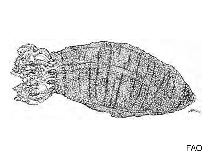Athyonidium chilensis (Semper, 1868)
Burrowing shaggy sea cucumber| Native range | All suitable habitat | Point map | Year 2050 |

|
| This map was computer-generated and has not yet been reviewed. |
| Athyonidium chilensis AquaMaps Data sources: GBIF OBIS |
Classification / Names Common names | Synonyms | CoL | ITIS | WoRMS
Holothuroidea | Dendrochirotida | Phyllophoridae
Environment: milieu / climate zone / depth range / distribution range Ecology
Benthic; depth range 0 - 7 m (Ref. 87801). Temperate; 7°S - 47°S, 82°W - 70°W (Ref. 107069)
Distribution Countries | FAO areas | Ecosystems | Occurrences | Introductions
Southeast Pacific: Peru and Chile.
Length at first maturity / Size / Weight / Age
Maturity: Lm ? range ? - ? cm
Life cycle and mating behavior Maturity | Reproduction | Spawning | Eggs | Fecundity | Larvae
Main reference
References | Coordinator | Collaborators
Servicio Nacional de Pesca y Acuicultura. 2011 Nomina de Especies. http://www.sernapesca.cl/index.php?option=com_remository&Itemid=47&func=startdown&id=5055 [Accessed 28 May 2012]. (Ref. 90098)
IUCN Red List Status
(Ref. 130435: Version 2025-1)
CITES status (Ref. 108899)
CMS (Ref. 116361)
Threat to humans
Human uses
Fisheries: commercial
| FishSource |
Tools
More information
Max. ages / sizes
Length-weight rel.
Length-length rel.
Length-frequencies
Mass conversion
Abundance
Internet sources
BHL | BOLD Systems | CISTI | DiscoverLife | FAO(Publication : search) | Fishipedia | GenBank (genome, nucleotide) | GloBI | Gomexsi | Google Books | Google Scholar | Google | PubMed | Tree of Life | Wikipedia (Go, Search) | Zoological Record



